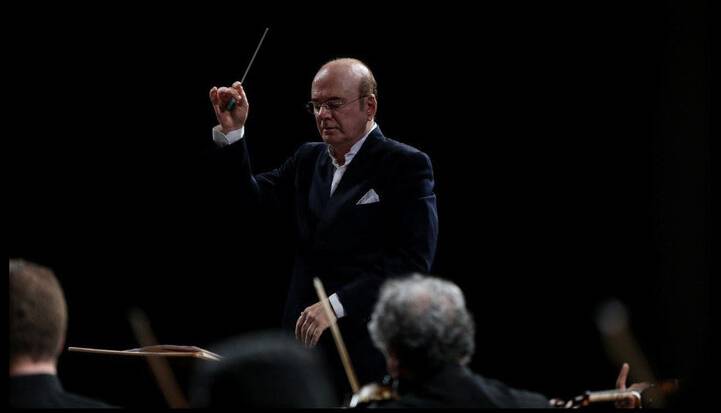
What is the true state of the Tehran Symphony Orchestra today? The orchestra’s permanent conductor, Manoochehr Sahbai, has been absent from its two most recent projects, both of which were conducted by guest conductors. His absence has raised many questions. Has Sahbai fallen victim to unstable management policies—the same policies that have earned our managers a reputation for being “warm in welcome, cold in farewell”?
What is the true state of the Tehran Symphony Orchestra today? The orchestra’s permanent conductor, Manoochehr Sahbai, has been absent from its two most recent projects, both of which were led by guest conductors. This absence has raised many questions. Has Sahbai become a victim of unstable management policies—the very same approach that has earned our managers a reputation for being “warm in welcome, cold in farewell”?
Usually, when inviting prominent conductors or even well-known sports coaches, officials launch extensive PR campaigns to showcase their foresight and judgment, presenting their choices as wise and well thought out. Photos of handshakes and arms around shoulders flood the news pages, and the sound of this “prudence” becomes loud and clear. But once the job is done, all that excitement and media buzz vanishes into silence and obscurity.
Why haven’t our officials learned that the end of a collaboration with experts and respected figures—those who were once invited with honor—should also be handled respectfully and appropriately? Has Manoochehr Sahbai met the same fate as figures like Shahrdad Rohani or Carlos Queiroz? This is a question that remains unanswered.
If that is not the case, why has there been complete media silence, with no transparent explanation from any cultural or artistic officials? Shouldn’t the music community and the audience of the Tehran Symphony Orchestra be informed of the reasons behind this situation? Transparency and accountability are not only ethical and managerial responsibilities—they are essential for restoring public trust in the Tehran Symphony Orchestra as one of the country’s major cultural institutions.
The last time the orchestra performed under its permanent conductor and artistic director, Manoochehr Sahbai, was in June of this year. After a hiatus during the months of Muharram and Safar, the orchestra returned to the stage in September with guest conductor Arash Gooran. Then in November, another concert was held under guest conductor Maziar Younesi. Yet in both the press conferences and the performances themselves, there was no sign of Manoochehr Sahbai, the orchestra’s permanent conductor and artistic director.
What really happened during the months of Muharram and Safar that led to such a shift in the orchestra’s policy? Who was involved in the decision to bring in guest conductors, and why is there no transparency about it? Was Manoochehr Sahbai, as the orchestra’s permanent conductor and artistic director, consulted in these choices? And if he is no longer in this position, and the orchestra is now operating without a permanent conductor or artistic director, how can the presence of guest conductors be justified?
Where in the world does a guest conductor make sense in the absence of a permanent one? A guest conductor is only meaningful when there is a firmly established permanent conductor, and collaborations with others are meant to enrich the orchestra’s programming. But in the absence of a permanent conductor, the policy adopted by the officials—holding concerts with guest conductors—feels more like saying: “Someone just come and conduct this concert, we’ll figure out the rest later!”
If that is not the case, why shouldn’t the public and music enthusiasts be informed of the truth? Transparency and accountability are not only the right of the people, but essential for preserving the dignity and credibility of the Tehran Symphony Orchestra. Another major question is: what criteria were used in selecting these guest conductors? Critics and even the orchestra’s musicians have expressed dissatisfaction with the recent management chaos and the quality of the concerts. This dissatisfaction reached a boiling point in November when, right before one of the performances, tensions backstage led to a conflict between some musicians and the guest conductor. The musicians then walked onstage visibly agitated, both mentally and emotionally.
What were the actual criteria behind these selections? How did some individuals receive the opportunity to stand in front of the Tehran Symphony Orchestra and conduct, despite sometimes lacking even the most basic skills of conducting? This situation has not only damaged the orchestra’s reputation but also negatively affected the musicians’ morale and the quality of performances. Are such poorly reasoned and opaque decisions befitting of a storied institution like the Tehran Symphony Orchestra?
Meanwhile, officials at the Rudaki Foundation seem intent on using statistics to present their performance as flawless. A prime example of this was a press release from the foundation’s PR team about a recent concert titled “Audience Satisfaction with the Iranian March Concert.” The news referenced a survey conducted via a QR code printed on the back of the concert brochure.
But here’s the catch: according to the report, out of roughly 1,400 people who attended the two-night concert at Vahdat Hall (with a 700-seat capacity per night), only 50 participated in the survey. Can such a tiny sample be considered statistically valid? And can it really serve as a foundation for a headline claiming “audience satisfaction”?
This is a clear case of trying to paint an unrealistic picture of performance, which not only fails to enhance the foundation’s credibility but also widens the gap between the music community and cultural officials.
In general, we expect the new government, which has held office for only a few months, to take a deeper and more sensitive look at the current state of the Tehran Symphony Orchestra—an institution that is both historic and symbolic of the country’s musical heritage. The Tehran Symphony Orchestra is not just a display of the grandeur of Iranian academic and artistic music; it is a cultural legacy that must be preserved as a national duty.
In particular, we look to Ms. Nadereh Rezaei, the new Deputy Minister of Culture for the Arts, to take prudent and practical steps to help improve the orchestra’s situation. Any positive decision or action in this regard would not only elevate the status of music in the country, but would also serve as a worthy response to the quiet perseverance of the orchestra’s musicians—those who, despite all the difficulties and shortcomings, continue to step onto the stage with dignity and devotion to their instruments, performing with artistry and heart.
These musicians, the very pillars of the orchestra, endure harsh conditions in silence, demonstrating their loyalty to music not with words but through their art. Don’t they deserve thoughtful planning and unwavering support from the country’s cultural officials? Any serious effort in this direction will not only restore the Tehran Symphony Orchestra’s prestige but also breathe new life into the cultural and artistic spirit of the nation.
Written By Farid Parish
